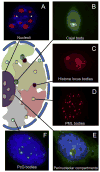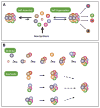Nuclear bodies: random aggregates of sticky proteins or crucibles of macromolecular assembly?
- PMID: 19922869
- PMCID: PMC3101021
- DOI: 10.1016/j.devcel.2009.10.017
Nuclear bodies: random aggregates of sticky proteins or crucibles of macromolecular assembly?
Abstract
The principles of self-assembly and self-organization are major tenets of molecular and cellular biology. Governed by these principles, the eukaryotic nucleus is composed of numerous subdomains and compartments, collectively described as nuclear bodies. Emerging evidence reveals that associations within and between various nuclear bodies and genomic loci are dynamic and can change in response to cellular signals. This review will discuss recent progress in our understanding of how nuclear body components come together, what happens when they form, and what benefit these subcellular structures may provide to the tissues or organisms in which they are found.
Figures




References
-
- Anderson P, Kedersha N. RNA granules: post-transcriptional and epigenetic modulators of gene expression. Nat Rev Mol Cell Biol. 2009;10:430–436. - PubMed
-
- Bernardi R, Pandolfi PP. Structure, dynamics and functions of promyelocytic leukaemia nuclear bodies. Nat Rev Mol Cell Biol. 2007;8:1006–1016. - PubMed
Publication types
MeSH terms
Substances
Grants and funding
LinkOut - more resources
Full Text Sources

